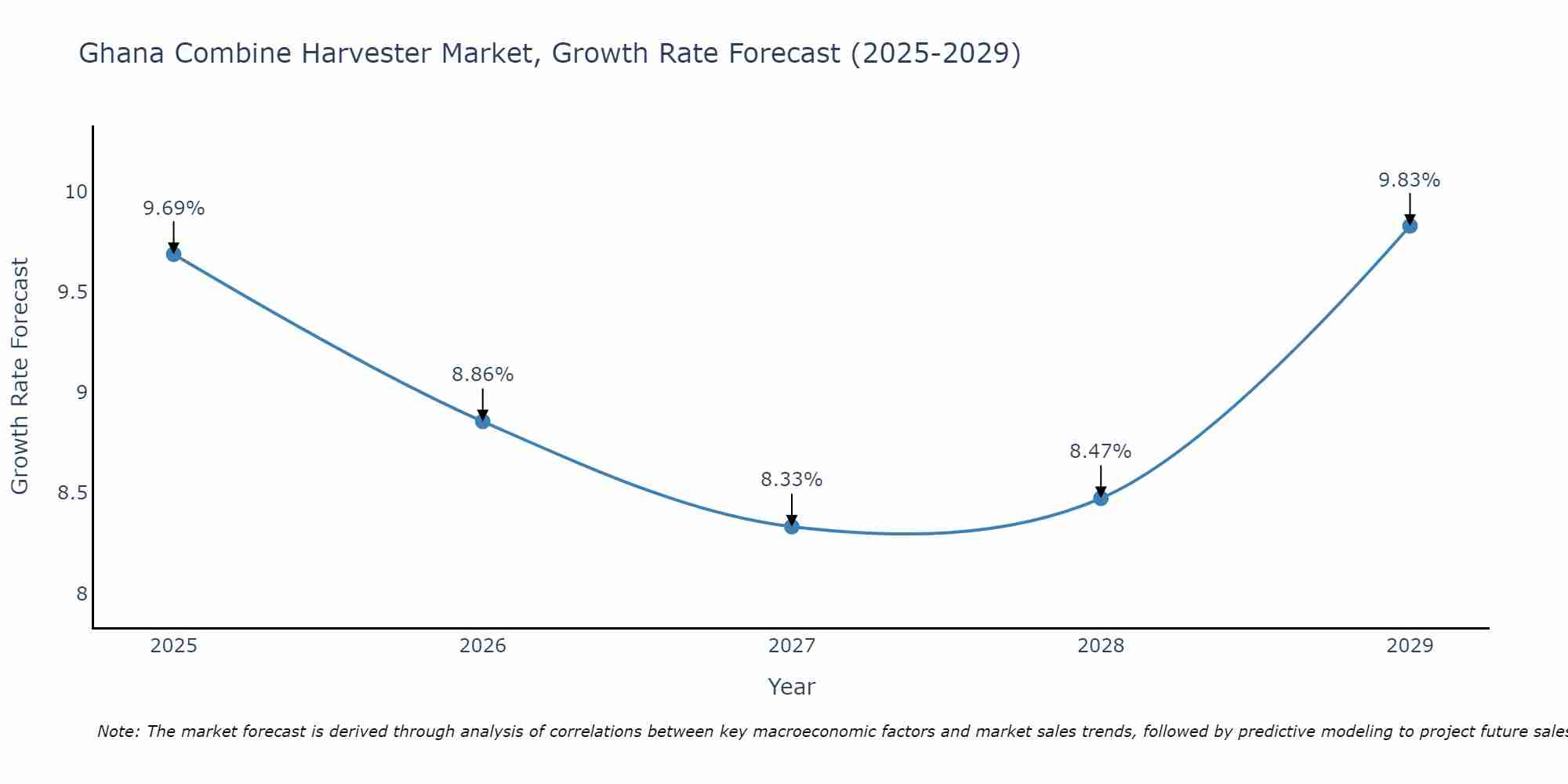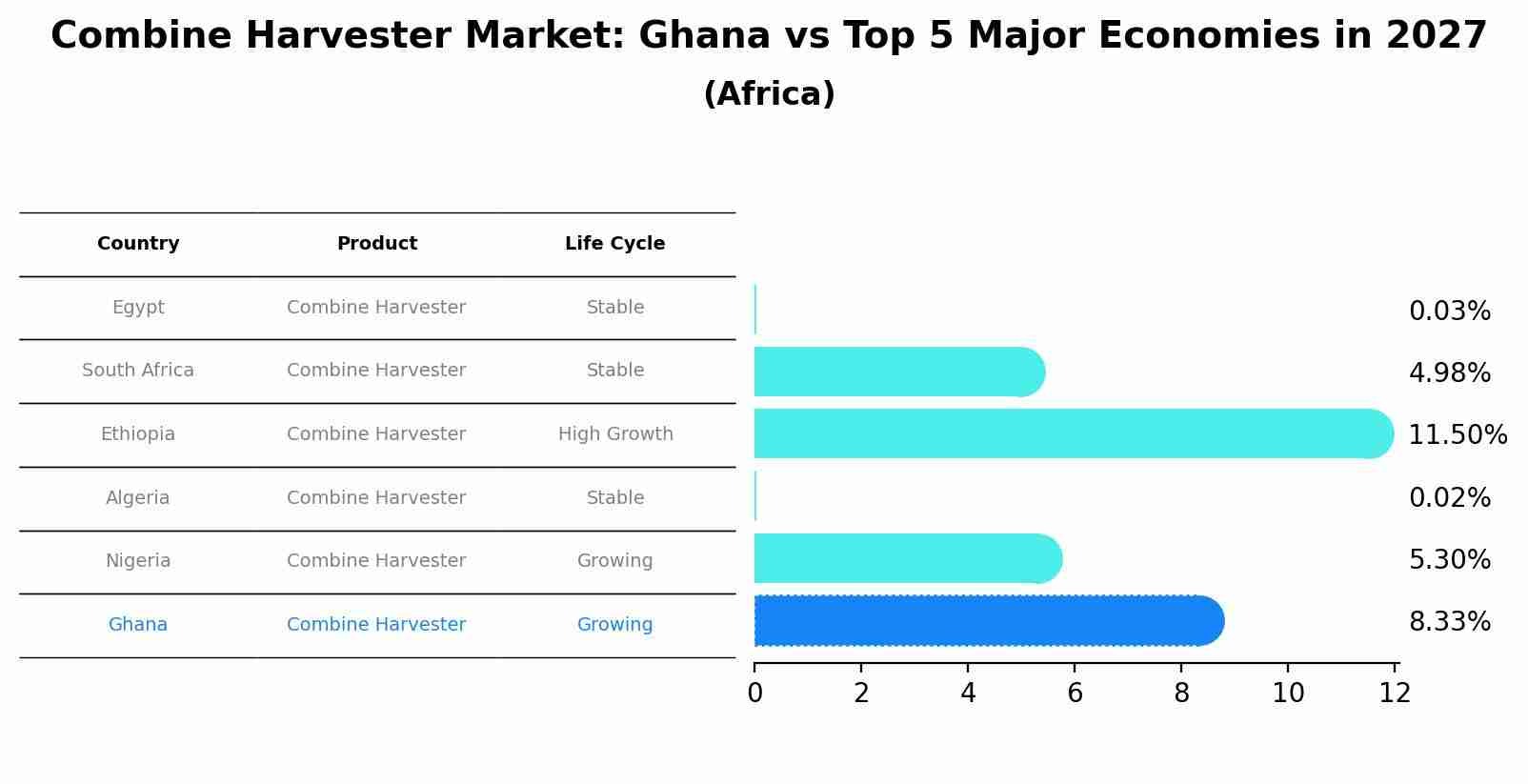Ghana Combine Harvester Market (2025-2031) Outlook | Growth, Industry, Share, Value, Forecast, Revenue, Companies, Analysis, Trends & Size
| Product Code: ETC428752 | Publication Date: Oct 2022 | Updated Date: Aug 2025 | Product Type: Market Research Report | |
| Publisher: 6Wresearch | Author: Shubham Padhi | No. of Pages: 75 | No. of Figures: 35 | No. of Tables: 20 |
Ghana Combine Harvester Market Size Growth Rate
The Ghana Combine Harvester Market is projected to witness mixed growth rate patterns during 2025 to 2029. The growth rate starts at 9.69% in 2025 and reaches 9.83% by 2029.

Combine Harvester Market: Ghana vs Top 5 Major Economies in 2027 (Africa)
By 2027, Ghana's Combine Harvester market is forecasted to achieve a growing growth rate of 8.33%, with Egypt leading the Africa region, followed by South Africa, Ethiopia, Algeria and Nigeria.

Ghana Combine Harvester Market Overview
Combine harvesters are agricultural machines used to harvest and thresh crops such as rice, wheat, and maize in Ghana agricultural sector. These machines offer efficiency, productivity, and labor savings compared to traditional harvesting methods, making them essential for large-scale farming operations. The Ghana combine harvester market is driven by the mechanization of agriculture, government support for farm mechanization programs, and the need to improve food security and rural livelihoods. Agricultural machinery manufacturers and distributors in Ghana are offering a range of combine harvester models and financing options to meet the needs of smallholder farmers and commercial agribusinesses.
Drivers of the market
Ghana agricultural sector is witnessing a shift towards mechanization to improve productivity and address labor shortages. The adoption of combine harvesters is driven by the government`s initiatives to modernize farming practices, increase agricultural output, and enhance food security, thereby reducing dependence on manual labor and traditional harvesting methods.
Challenges of the market
Challenges facing the combine harvester market in Ghana include limited access to agricultural machinery financing and technical support services. Moreover, land tenure issues and smallholder farming practices impact market penetration and adoption of mechanized harvesting solutions.
Government Policy of the market
Recognizing the potential of mechanized farming to enhance agricultural productivity and food security, the government may introduce policies to support the growth of the combine harvester market. These policies may include initiatives to provide financial incentives for farmers to adopt mechanized harvesting technologies, promote investment in combine harvester manufacturing and distribution infrastructure, and facilitate access to finance and technology for smallholder farmers. Additionally, the government may implement measures to support skills development and training in combine harvester operation and maintenance, ensure availability of spare parts and aftersales services, and promote research and development in advanced harvesting technologies to address the evolving needs of Ghana agriculture.
Key Highlights of the Report:
- Ghana Combine Harvester Market Outlook
- Market Size of Ghana Combine Harvester Market, 2024
- Forecast of Ghana Combine Harvester Market, 2031
- Historical Data and Forecast of Ghana Combine Harvester Revenues & Volume for the Period 2021-2031
- Ghana Combine Harvester Market Trend Evolution
- Ghana Combine Harvester Market Drivers and Challenges
- Ghana Combine Harvester Price Trends
- Ghana Combine Harvester Porter's Five Forces
- Ghana Combine Harvester Industry Life Cycle
- Historical Data and Forecast of Ghana Combine Harvester Market Revenues & Volume By Cutting Width for the Period 2021-2031
- Historical Data and Forecast of Ghana Combine Harvester Market Revenues & Volume By Small Size Combine Harvester for the Period 2021-2031
- Historical Data and Forecast of Ghana Combine Harvester Market Revenues & Volume By Large Size Combine Harvester for the Period 2021-2031
- Historical Data and Forecast of Ghana Combine Harvester Market Revenues & Volume By Type for the Period 2021-2031
- Historical Data and Forecast of Ghana Combine Harvester Market Revenues & Volume By Wheel Type Combine Harvester for the Period 2021-2031
- Historical Data and Forecast of Ghana Combine Harvester Market Revenues & Volume By Crawler Type Combine Harvester for the Period 2021-2031
- Historical Data and Forecast of Ghana Combine Harvester Market Revenues & Volume By Power Source for the Period 2021-2031
- Historical Data and Forecast of Ghana Combine Harvester Market Revenues & Volume By Tractor Pulled/PTO Powered Combine Harvester for the Period 2021-2031
- Historical Data and Forecast of Ghana Combine Harvester Market Revenues & Volume By Self-Propelled Combine Harvester for the Period 2021-2031
- Ghana Combine Harvester Import Export Trade Statistics
- Market Opportunity Assessment By Cutting Width
- Market Opportunity Assessment By Type
- Market Opportunity Assessment By Power Source
- Ghana Combine Harvester Top Companies Market Share
- Ghana Combine Harvester Competitive Benchmarking By Technical and Operational Parameters
- Ghana Combine Harvester Company Profiles
- Ghana Combine Harvester Key Strategic Recommendations
Frequently Asked Questions About the Market Study (FAQs):
1 Executive Summary |
2 Introduction |
2.1 Key Highlights of the Report |
2.2 Report Description |
2.3 Market Scope & Segmentation |
2.4 Research Methodology |
2.5 Assumptions |
3 Ghana Combine Harvester Market Overview |
3.1 Ghana Country Macro Economic Indicators |
3.2 Ghana Combine Harvester Market Revenues & Volume, 2021 & 2031F |
3.3 Ghana Combine Harvester Market - Industry Life Cycle |
3.4 Ghana Combine Harvester Market - Porter's Five Forces |
3.5 Ghana Combine Harvester Market Revenues & Volume Share, By Cutting Width, 2021 & 2031F |
3.6 Ghana Combine Harvester Market Revenues & Volume Share, By Type, 2021 & 2031F |
3.7 Ghana Combine Harvester Market Revenues & Volume Share, By Power Source, 2021 & 2031F |
4 Ghana Combine Harvester Market Dynamics |
4.1 Impact Analysis |
4.2 Market Drivers |
4.2.1 Increasing demand for efficient farming equipment to improve agricultural productivity in Ghana |
4.2.2 Government initiatives to promote mechanized farming practices |
4.2.3 Technological advancements in combine harvesters leading to improved efficiency and performance |
4.3 Market Restraints |
4.3.1 High initial investment cost of combine harvesters |
4.3.2 Limited access to financing options for small-scale farmers in Ghana |
4.3.3 Lack of proper infrastructure and support services for maintenance and repair of combine harvesters |
5 Ghana Combine Harvester Market Trends |
6 Ghana Combine Harvester Market, By Types |
6.1 Ghana Combine Harvester Market, By Cutting Width |
6.1.1 Overview and Analysis |
6.1.2 Ghana Combine Harvester Market Revenues & Volume, By Cutting Width, 2021-2031F |
6.1.3 Ghana Combine Harvester Market Revenues & Volume, By Small Size Combine Harvester, 2021-2031F |
6.1.4 Ghana Combine Harvester Market Revenues & Volume, By Large Size Combine Harvester, 2021-2031F |
6.2 Ghana Combine Harvester Market, By Type |
6.2.1 Overview and Analysis |
6.2.2 Ghana Combine Harvester Market Revenues & Volume, By Wheel Type Combine Harvester, 2021-2031F |
6.2.3 Ghana Combine Harvester Market Revenues & Volume, By Crawler Type Combine Harvester, 2021-2031F |
6.3 Ghana Combine Harvester Market, By Power Source |
6.3.1 Overview and Analysis |
6.3.2 Ghana Combine Harvester Market Revenues & Volume, By Tractor Pulled/PTO Powered Combine Harvester, 2021-2031F |
6.3.3 Ghana Combine Harvester Market Revenues & Volume, By Self-Propelled Combine Harvester, 2021-2031F |
7 Ghana Combine Harvester Market Import-Export Trade Statistics |
7.1 Ghana Combine Harvester Market Export to Major Countries |
7.2 Ghana Combine Harvester Market Imports from Major Countries |
8 Ghana Combine Harvester Market Key Performance Indicators |
8.1 Average utilization rate of combine harvesters in Ghana |
8.2 Adoption rate of mechanized farming practices in the agriculture sector |
8.3 Average age of combine harvesters in operation in Ghana |
9 Ghana Combine Harvester Market - Opportunity Assessment |
9.1 Ghana Combine Harvester Market Opportunity Assessment, By Cutting Width, 2021 & 2031F |
9.2 Ghana Combine Harvester Market Opportunity Assessment, By Type, 2021 & 2031F |
9.3 Ghana Combine Harvester Market Opportunity Assessment, By Power Source, 2021 & 2031F |
10 Ghana Combine Harvester Market - Competitive Landscape |
10.1 Ghana Combine Harvester Market Revenue Share, By Companies, 2024 |
10.2 Ghana Combine Harvester Market Competitive Benchmarking, By Operating and Technical Parameters |
11 Company Profiles |
12 Recommendations |
13 Disclaimer |
- Single User License$ 1,995
- Department License$ 2,400
- Site License$ 3,120
- Global License$ 3,795
Search
Thought Leadership and Analyst Meet
Our Clients
Related Reports
- Germany Breakfast Food Market (2026-2032) | Industry, Share, Growth, Size, Companies, Value, Analysis, Revenue, Trends, Forecast & Outlook
- Australia Briquette Market (2025-2031) | Growth, Size, Revenue, Forecast, Analysis, Trends, Value, Share, Industry & Companies
- Vietnam System Integrator Market (2025-2031) | Size, Companies, Analysis, Industry, Value, Forecast, Growth, Trends, Revenue & Share
- ASEAN and Thailand Brain Health Supplements Market (2025-2031) | Strategy, Consumer Insights, Analysis, Investment Trends, Opportunities, Growth, Size, Share, Industry, Revenue, Segments, Value, Segmentation, Supply, Forecast, Restraints, Outlook, Competition, Drivers, Trends, Demand, Pricing Analysis, Competitive, Strategic Insights, Companies, Challenges
- ASEAN Bearings Market (2025-2031) | Strategy, Consumer Insights, Analysis, Investment Trends, Opportunities, Growth, Size, Share, Industry, Revenue, Segments, Value, Segmentation, Supply, Forecast, Restraints, Outlook, Competition, Drivers, Trends, Demand, Pricing Analysis, Competitive, Strategic Insights, Companies, Challenges
- Europe Flooring Market (2025-2031) | Outlook, Share, Industry, Trends, Forecast, Companies, Revenue, Size, Analysis, Growth & Value
- Saudi Arabia Manlift Market (2025-2031) | Outlook, Size, Growth, Trends, Companies, Industry, Revenue, Value, Share, Forecast & Analysis
- Uganda Excavator, Crane, and Wheel Loaders Market (2025-2031) | Strategy, Consumer Insights, Analysis, Investment Trends, Opportunities, Growth, Size, Share, Industry, Revenue, Segments, Value, Segmentation, Supply, Forecast, Restraints, Outlook, Competition, Drivers, Trends, Demand, Pricing Analysis, Competitive, Strategic Insights, Companies, Challenges
- Rwanda Excavator, Crane, and Wheel Loaders Market (2025-2031) | Strategy, Consumer Insights, Analysis, Investment Trends, Opportunities, Growth, Size, Share, Industry, Revenue, Segments, Value, Segmentation, Supply, Forecast, Restraints, Outlook, Competition, Drivers, Trends, Demand, Pricing Analysis, Competitive, Strategic Insights, Companies, Challenges
- Kenya Excavator, Crane, and Wheel Loaders Market (2025-2031) | Strategy, Consumer Insights, Analysis, Investment Trends, Opportunities, Growth, Size, Share, Industry, Revenue, Segments, Value, Segmentation, Supply, Forecast, Restraints, Outlook, Competition, Drivers, Trends, Demand, Pricing Analysis, Competitive, Strategic Insights, Companies, Challenges
Industry Events and Analyst Meet
Whitepaper
- Middle East & Africa Commercial Security Market Click here to view more.
- Middle East & Africa Fire Safety Systems & Equipment Market Click here to view more.
- GCC Drone Market Click here to view more.
- Middle East Lighting Fixture Market Click here to view more.
- GCC Physical & Perimeter Security Market Click here to view more.
6WResearch In News
- Doha a strategic location for EV manufacturing hub: IPA Qatar
- Demand for luxury TVs surging in the GCC, says Samsung
- Empowering Growth: The Thriving Journey of Bangladesh’s Cable Industry
- Demand for luxury TVs surging in the GCC, says Samsung
- Video call with a traditional healer? Once unthinkable, it’s now common in South Africa
- Intelligent Buildings To Smooth GCC’s Path To Net Zero


















